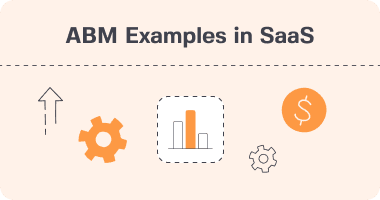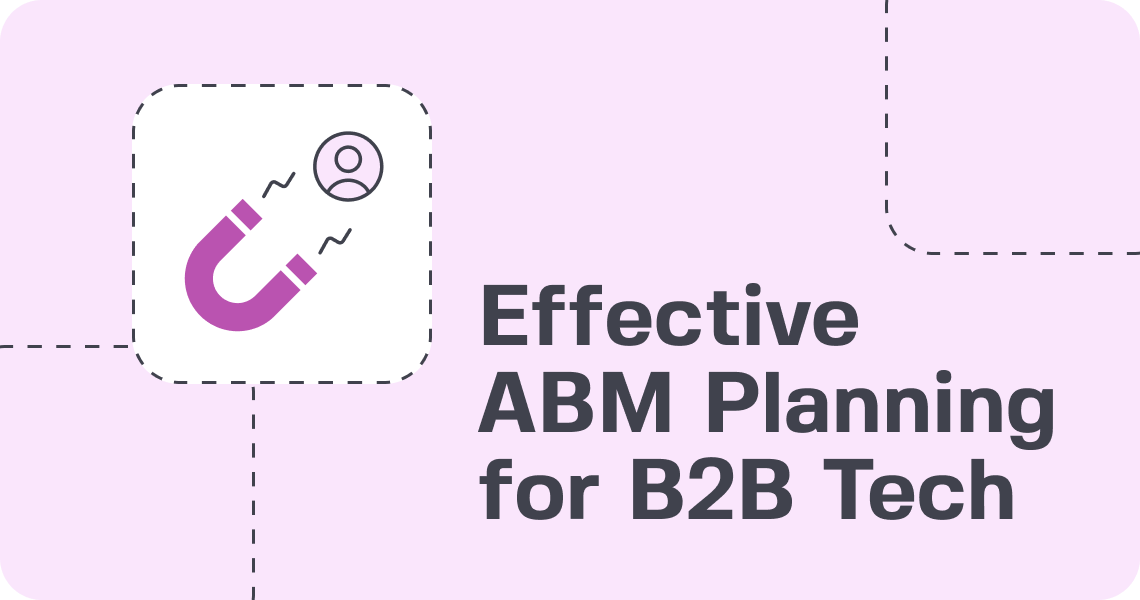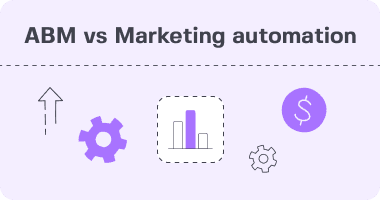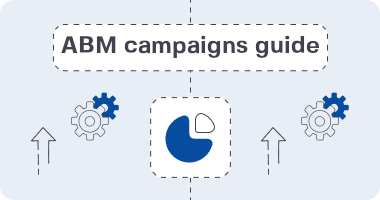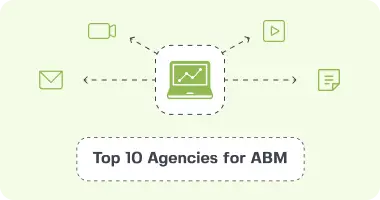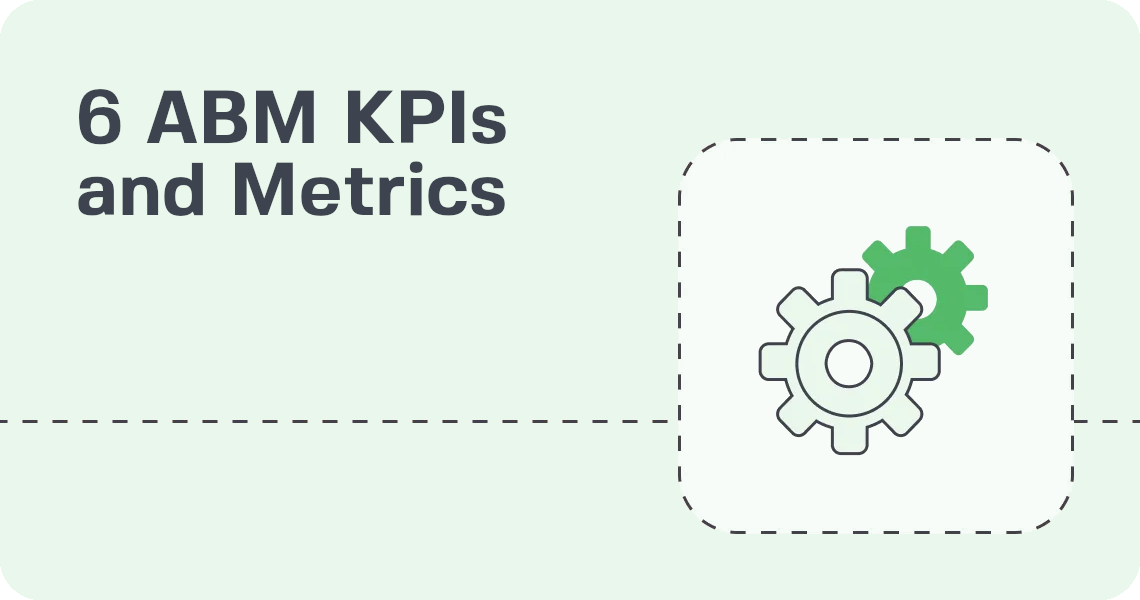An account based marketing framework is a focused approach that uses personalized campaigns to engage deeply with a company’s most valuable accounts. This framework is designed to help align sales and marketing efforts. It personalizes campaigns to address the unique pain points of each account, allowing companies to forge deeper connections and generate greater revenue.
It’s built around essential elements such as account selection, tailored messaging and data-driven insights to help achieve maximum precision in targeting. As a matter of fact, this strategy has been adopted across B2B sectors. With long sales cycles and complex decision-making processes, a more targeted approach is necessary.
In this post, I’ll unpack the key components of an effective account-based marketing framework. Best of all, I’m going to give you practical insights to make it shown and help you implement it well in your organization.
What is Account-Based Marketing (ABM)?
Account-Based Marketing (ABM) is a strategic approach ideally suited for B2B companies. It’s all about deeply personalizing your marketing strategy to a small group of prioritized high-value accounts. ABM marketing takes a different approach by treating each target account like its own market.

It personalizes each interaction, so it’s addressing the unique needs, challenges, and objectives of that account. This degree of customization cuts your time and money to the most lucrative prospects. As such, it represents a radical improvement in efficiency over traditional marketing practices.
Close collective sales and marketing collaboration is a fundamental tenet of ABM. By collaborating, these teams—namely, marketing and sales—can develop a coordinated approach that improves the customer experience at every stage of the purchase pipeline.
Marketing plays its role by creating hyper-targeted content, but sales round out the picture by sharing valuable intel about that account’s unique pain points. If a SaaS for healthcare companies is the target, marketing teams will develop case studies about winning on the healthcare tech battlefield.
At the same time, sales teams will be demonstrating product capabilities to solve industry pain points. Together, this synergy propels higher engagement and creates trust and credibility.
Whether derived from research or past interactions, a deeper understanding of each persona’s unique pain points is critical for ABM success. For instance, if a manufacturing client struggles with supply chain inefficiencies, presenting tailored solutions such as predictive analytics tools can position your business as indispensable.
ABM isn’t only about net-new account acquisition; it’s a powerful long-term approach to help keep your best customers long-term and increase their revenue contribution. With 91% of marketers reporting larger deal sizes and 25% seeing over 50% growth, ABM proves its value when executed thoughtfully.

What is an Account-Based Marketing Framework?
A well-crafted account based marketing framework is a great way to lay a strong, thoughtful foundation. It positions marketing, sales, and customer success teams to most effectively land and expand those high-value accounts.
This framework seriously addresses the need for more one-to-one, personalized campaigns targeted to individual accounts. Focusing more on quality rather than quantity increases cash flow with laser-focused campaigns.
The framework integrates data, analytics and human insight. It helps develop a clear, well-defined plan that aligns your marketing and sales efforts, so they’re both focused on achieving the same goals.
1. Define ABM Framework Key Components
The ICP is the foundation of the ABM framework. This important step allows you to identify the accounts that will be the best fit for your expected revenue needs.
This profile uses three data sources: qualitative insights from sales teams, historical internal data, and external predictive analytics. After the ICP has been agreed upon, key stakeholder personas are created, outlining their roles, challenges, and motivations.
Personalized messaging is created so it aligns with each persona’s needs, improving content relevancy. Technology is foundational to account-based marketing as it allows for executing data-driven strategies, campaign management, and tracking performance against goals.
2. Explain the Structure of ABM Framework
The framework follows three phases: planning, execution, and evaluation. Planning helps you hone in on which accounts to target and what you want to achieve.
Execution is through multichannel campaigns, including a sequence of email, phone, and social touches over two to three weeks. Evaluation measures both output and outcome, measuring the performance of the pipeline between targeted accounts vs nontargeted accounts.
Agility allows you to pivot and iterate as market forces, buyer behaviors, and competitor activities shift.
3. ABM vs. Traditional Marketing
In direct opposition to traditional marketing’s wide net approach, ABM focuses on a defined set of targeted accounts, frequently resulting in 87% higher ROI.
Its ability to track outcomes and engagement solely with high-value accounts set it apart as a more precise and targeted strategy.
Assess Your ABM Readiness
To effectively implement an Account-Based Marketing (ABM) framework, assessing your readiness is critical. This involves examining internal alignment, resources, and leadership commitment, all of which set the foundation for ABM success.
Evaluate Organizational Alignment
A well-synced relationship between sales and marketing is key for ABM Purchase alignment. Both marketing and sales need to be aligned to target accounts, shared goals, and what success looks like.
For example, if sales is focused on closing deals at all costs and marketing is still responsible for generating leads, it will be difficult to meet ABM goals. Collaborative tools—be it a CRM platform or shared account plan—can go a long way to closing that gap, promoting transparency and collaboration.
Identify Resources and Capabilities
Your current resources play a key role in determining ABM feasibility. Do you have a robust CRM system to track accounts and engagement?
Is your team skilled in data analysis and personalization techniques? For example, if personalized content creation is limited, consider investing in tools that automate tailored messaging. Assessing these capabilities upfront helps pinpoint areas requiring improvement.
Leadership Commitment
Leadership’s buy-in directly impacts the success of ABM adoption. Without active support, ensuring budgets, tools, and collaboration across departments cannot quickly fall through the cracks.
Executive leadership can help build the case for ABM by articulating what success looks like for the organization. For instance, showing that ABM-led campaigns are responsible for greater ROI than more conventional approaches will help encourage wider buy-in.
ABM-Fit Checklist Questions
- Do we have clearly defined target accounts?
- Are sales and marketing aligned on shared goals?
- Do we leverage technology to manage account data effectively?
- Do you have a process for continual account review and optimization?
Avoid Common ABM Failure Reasons
Overlooking the importance of team alignment or using old, stale data can tank an ABM initiative before it ever gets started.
Smart research helps you zero in on the right accounts, and tracking important metrics such as account engagement over time will keep you on the path to success.

Build Your ABM Strategy
An Account-Based Marketing (ABM) strategy needs to be carefully and methodically developed to produce the impactful results you desire. At its core, ABM aligns marketing efforts with sales objectives, targeting high-value accounts through personalized tactics. Let’s take a look at all the key parts.
1. Define Clear ABM Goals
Setting clear, measurable objectives is step number one. These goals must be linked closely to business results, like boosting revenue or enhancing customer engagement. For instance, set a specific revenue growth goal of 20% in top accounts over the next six months.
This makes it a very clear, frank and actionable goal. By prioritizing these goals, you’ll make sure your time and energy are spent on initiatives that have the biggest potential impact. Communicating them effectively across all pipeline-producing future-strategists in marketing and sales ensures alignment and shared accountability.
2. Identify Ideal Customer Profile (ICP)
A strong ICP marries firmographic data, such as company size, industry, and revenue, with behavioral insights. For instance, an ideal target profile for a B2B tech firm could be mid-market companies within financial services that understand the need for better cybersecurity solutions.
This profile informs the selection of accounts and is used to shape the messaging that will best speak to each target audience. Continuously refining the ICP keeps it aligned with changing market dynamics and internal learnings from sales and marketing efforts.
3. Firmographic Data Importance
This is where firmographic data becomes increasingly vital to your segmentation and targeting efforts. For example, company growth trends or geographic location may be factors that indicate high-value accounts and save time when sorting through prospects.
For example, it might be more profitable to target quickly-growing series A or B startups in Silicon Valley rather than broadly going after all tech companies.
4. Map the Buying Committee Members
Real ABM means really knowing how decision-makers operate. Peer mapping stakeholders—CFOs, IT managers, and procurement leads—helps clarify roles, revolutionizing how you conceive engagement strategy.
By proactively addressing their unique concerns with tailored messages that resonate with them, you’ll build trust and ultimately drive their decisions.

Execute Effective ABM Plays
Executing Account Based Marketing (ABM) takes intention, thought and a process – in order to have the right interactions and engagements with these target accounts. By honing in on specific, high-value plays, tracking their success, and innovating accordingly with data in hand, you’ll be able to nurture your best opportunities.
Warm-Up and Activation Playbook
Having a clear playbook is essential to getting target accounts warmed up and engaged before any actual outreach has started. Begin by identifying actions to create a sense of comfort, like presenting personalized content or drawing on past experiences.
For example, posting case studies relevant to an account’s industry pain points shows them you understand their struggles and can engage them before you pitch. So be sure to make this joint playbook available to both the marketing and the sales teams to avoid execution shortcomings.
This alignment is extremely important since leads from the SMB market rarely fit your solution. A coordinated approach ensures that you are driving more highly-qualified leads.
Content Collaboration Strategies
Close collaboration between content creators and sales teams is crucial to inform the audience through targeted messaging. Create collateral that speaks to each one’s individual pain points, like an ROI-focused whitepaper that your ideal clients would appreciate.
Tools for collaboration, such as shared content calendars, can help keep things moving and ensure uniformity. This one strategy connects silos between departments, creating the alignment that’s usually difficult to find in ABM efforts.
Host Engaging Virtual Events
Virtual events offer an unrivaled opportunity to highlight your thought leadership, all while making a real connection with the people that matter most. Aligning those types of events with specific interests, such as holding industry-specific webinars, helps you build your organization’s reputation as a thought leader.
Post-event follow-up is crucial. Keeping the leads you’ve cultivated intact and nurtured properly will help further solidify your new pipeline build-out in less than 30 days.
Drive Social Engagement
Social media is a popular channel for ABM and an effective way to engage your target accounts. Whether it’s sharing actionable insights or jumping into a discussion, showing a willingness to provide value without expectation helps you develop quality relationships.
Measuring how your audience interacts with you across channels—including LinkedIn—enables you to find the right opportunities to drive more meaningful engagement.

Align Teams and Technology
To effectively implement an account-based marketing (ABM) framework, it’s vital to bring the sales and marketing teams into alignment. Both teams need to do so with aligned goals, knowledge and strategies to pursue high-value accounts. When departments work together, they are able to clearly align marketing campaigns to back up sales initiatives.
This teamwork ensures a seamless and engaging customer experience. For instance, if sales identify key decision-makers within a target account, marketing can craft personalized content to engage those individuals directly. This alignment promotes greater consistency and effectiveness when executing ABM campaigns.
Technology becomes a key enabler to ensure this collaboration can happen. Customer relationship management (CRM) systems and marketing automation strategies facilitate companies by making it easy to share data. These tools help ensure teams stay informed with real-time insights into account activity.
For example, platforms like Salesforce or HubSpot allow both teams to track account interactions, measure campaign performance, and adjust strategies accordingly. Communication tools like Slack or Microsoft Teams keep transparency in play and make discussions more active across the board, breaking down silos between departments.
It’s imperative to routinely review team structures and processes. As ABM strategies develop and mature, it’s worth taking a step back to evaluate if the existing setup still promotes the framework’s objectives. This may require re-thinking roles, re-establishing workflows, or integrating new technology to meet evolving challenges.
For instance, if there are bottlenecks in lead handoff processes, introducing shared dashboards or automation notifying teammates of delays can solve the issue. By constantly improving these key areas, organizations can keep a pulse on what’s most effective and further fuel momentum in their ABM initiatives.
Track, Measure, and Optimize ABM Performance
Measuring the success of your Account-Based Marketing (ABM) strategies is integral to maintain effectiveness over time. Due to the alignment towards high-value accounts, ABM has more defined metrics and actionable insights than traditional marketing campaigns. Measuring and optimizing performance requires a disciplined process and the right technology.
Reporting and Tracking Key Metrics
The first step to measuring ABM performance is setting up a strong tracking system. Critical metrics such as engagement rates, conversion rates, and account movement along the ABM funnel indicate campaign success and impact. They provide you with concrete evidence of what’s effective and what’s not.
For instance, measuring the number of target accounts that engage with personalized outreach could tell you how effective you are being in engaging your targets. Dashboards are a key component to this effort, synthesizing data into their visualizations so users can more easily discern trends at a glance.
Monitoring and measuring success regularly reviewing these reports provides a solid foundation to keep strategies agile and responsive. For example, if one account appears to be getting lower engagement, you can quickly pivot as necessary to get messaging back on track.
Use Data Analytics for Optimization
Data analytics tools can be instrumental in helping you identify patterns in account behavior and overall campaign effectiveness. Tools such as predictive analytics can support this by helping identify which accounts are most likely to engage further, enabling your team to further refine targeting strategies.
Testing and iterating based on data insights—for example, using A/B tests to inform specialized messaging—feels like a simple step but guarantees ongoing refinement and optimization. For instance, if analytics reveal that one channel is consistently resulting in greater engagement, teams can shift resources to those channels to ensure the greatest impact.
Calculate ABM ROI Effectively
These calculations should cover tangible returns, such as increased revenue, as well as intangible returns, such as better brand recognition. Having a definitive methodology in place, like tracking cost per account compared to revenue earned, can help make the case for continuing to invest in ABM approaches.
This is where CRM data comes in, providing clear, measurable evidence of lead quality and campaign effectiveness.

How to Overcome ABM Challenges
While Account-Based Marketing (ABM) is known for its ability to deliver more targeted engagement and greater ROI, it comes with its share of obstacles. Recognizing these challenges and approaching them strategically will set you up for long-term success.
Common ABM Mistakes to Avoid
One of the biggest mistakes made is skipping comprehensive account research. Without clear insights, targeting is inaccurate, resulting in poor leads or misaligned accounts. For example, going after the little guys who don’t have the budget to invest in your solution drains time and money.
Just as critical is marketing and sales team alignment. Without cross-team communication, working together becomes an immense obstacle that leads to inefficient outreach efforts. In particular, weekly reports on high-level metrics such as meetings booked or accounts engaged, which are distributed to senior leadership, can help close that gap.
Another major challenge is not setting realistic expectations for the outcomes of ABM. Overpromising results will only cause future disappointment. A pilot project is a more controlled way to test out strategies while ensuring clear goals with measurable outcomes.
Mitigate Potential Pitfalls
Contingency planning will be crucial to manage these risks. For instance, if a targeted account goes dark, having these other options prevents a halt in progress. Conducting quarterly or bi-annual reviews keeps you agile, allowing you to tackle new challenges as they arise.
When teams cultivate an environment of honest and open communication, they can address potential issues before they become problems. According to McKinsey’s research, 71% of consumers say they now prefer personalized interactions. Falling short on this expectation can derail ABM initiatives.
Never stop evaluating the land you’re standing on. Monitor changes in customer behavior and market trends to improve your strategy and maintain a competitive edge continually.

Future of ABM
Account-Based Marketing (ABM) has been changing at breakneck speed. To remain competitive in the future, businesses need to change with the times. Buyer behaviors, trends, and technology are evolving rapidly. Becoming indispensable, ABM has grown from a niche practice into an indispensable force within the B2B world.
Today, it fuels deeper engagement and produces far more impactful results. To avoid falling behind, businesses need to innovate and optimize their strategies to better align with the needs of an ever-evolving market landscape.
Evolving Buyer Behaviors Impact
Together, these shifts in buyer behavior are having a profound effect on ABM strategies. Buyers today are used to getting hyper-personalized experiences customized to their individual needs and wants. That means really understanding what’s motivating their decisions and using data to stay one step ahead of what they’re likely to expect.
Let’s say a healthcare organization that sells to big hospital systems wants to use intent data. This ensures them pinpoint decision-makers who share a taste for innovative telehealth solutions. By tailoring marketing efforts to these insights, businesses can develop more targeted campaigns that speak directly to their audiences and drive greater relevance and resonance.

In order to be successful with these emerging changes, you need to be agile. Integrated, omnichannel buyer experiences are essential, as buyers expect a seamless, digital-first experience at every turn.
Emerging Trends in ABM Strategies
A few key trends are driving ABM’s future, but none is paving the way like personalization. Digital technologies such as cloud-based CRMs and AI-powered platforms are increasing the efficiency of ABM. They allow for and facilitate highly granular account-level targeting and improved measurement.
Investment in ABM software is increasing, giving marketers the ability to better consolidate data, build targeted strategies, and scale their campaigns in an efficient manner. A willingness to experiment with new tactics like the use of predictive analytics and real-time engagement tools is key to ongoing relevance.
ABM is a long game that needs depth of planning and precision. Unsurprisingly, 91% of marketers report it driving bigger deal sizes, creating a great long-term investment.


